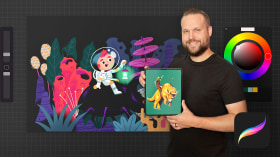Illustration tutorial: how to draw shadows with India ink
5 basic tips from Sergio Bleda to learn how to shade with ink taking into account the light focus
Shading is used to give volume to what is being drawn, to make something flat three-dimensional. In the design process of a comic or cartoon, inking and shading are fundamental parts to know the space in which an object or character is located, as well as to understand where the light is coming from.
Sergio Bleda (@sergibleda), cartoonist and illustrator, shows you his tricks to learn how to shade with India ink like an expert. To follow his advice you will only need: two synthetic brushes number 1 and number 2, 300 grams Canson paper and Winsor & Newton India ink.
5 basic tips for shading:
- Tip 1: ink before shading. It is important that you transfer the drawing from pencil to ink before starting the shading process. This will allow you to preview the drawing and we can start from the already marked lines to draw the shadows.

Tip 2: take into account the direction of the light. Light can come from different points, so be aware that the shadow will always be cast on the opposite side from the one it comes from. That is, if the light is from above, the shadows will be cast downwards. In addition, it is important to take into account what you shade, because it can contain different types of shadows. If, for example, you shade a face, you should respect the volume and shadows of the hair, nose, chin and eyes. Shading these elements will give the face three-dimensionality.

Types of light that you can find in the drawings:
1. Overhead or zenithal light: is the most commonly used. Shadows are usually cast under the nose, on the cheeks, between the eyebrows and on the neck.

2. Sidelight: here one side would be much more shaded than the other.

3. Two irregular spotlights: This is a slightly more complicated effect and is used a lot in American comics. The side where the light is less powerful is practically in shadow.











0 komentarzy